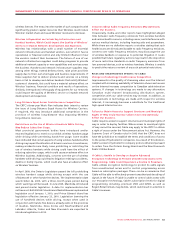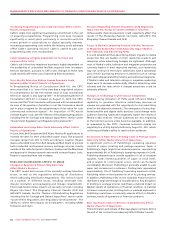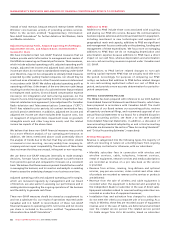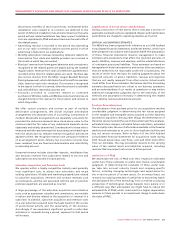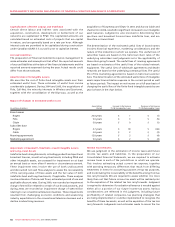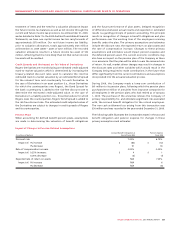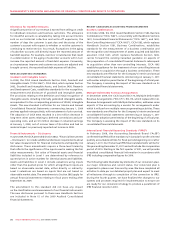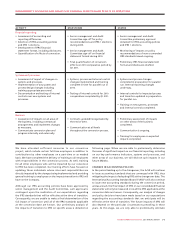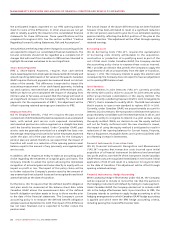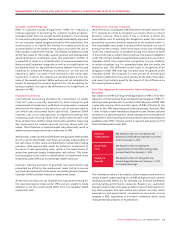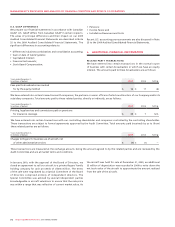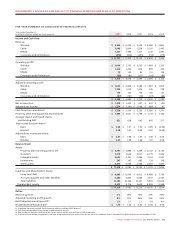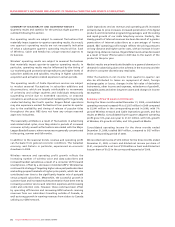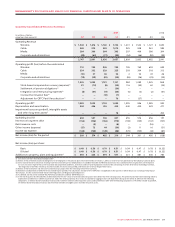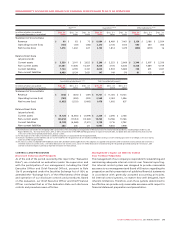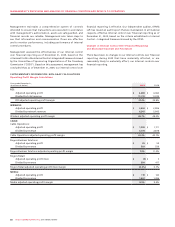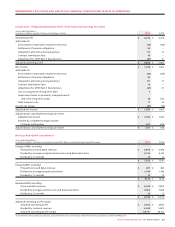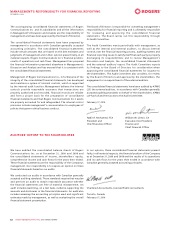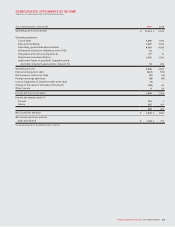Rogers 2009 Annual Report Download - page 69
Download and view the complete annual report
Please find page 69 of the 2009 Rogers annual report below. You can navigate through the pages in the report by either clicking on the pages listed below, or by using the keyword search tool below to find specific information within the annual report.
ROGERS COMMUNICATIONS INC. 2009 ANNUAL REPORT 73
MANAGEMENT’S DISCUSSION AND ANALYSIS OF FINANCIAL CONDITION AND RESULTS OF OPERATIONS
Customer Loyalty Programs
IFRIC 13 Customer Loyalty Programmes (“IFRIC 13”) requires a
revenue approach in accounting for customer loyalty programs.
Canadian GAAP does not provide specific guidance on accounting
for customer loyalty programs. We have adopted a liability approach
for our customer loyalty program offered to Fido subscribers. The
current policy is to classify the liability for loyalty points as an
accrued liability on the balance sheet and to record the net cost of
the program in equipment revenue. The liability is initially recorded
at the face value of the loyalty awards granted and subsequently
adjusted based on redemption rates. The application of IFRIC 13
is expected to result in a reclassification of revenue between the
Network and Equipment categories as well as a reclassification on
the balance sheet for the deferred revenue balance from Accrued
Liabilities to Unearned Revenue. Furthermore, we will also be
required to defer a portion of the revenue for the initial sales
transaction in which the awards are granted based on the fair
value of the awards granted. While we have not yet calculated the
impact of applying the revenue approach for the accounting for
loyalty programs, we expect the difference to be insignificant on
adoption of IFRS.
Impairment of Assets
International Accounting Standard 36, Impairment of Assets
(“IAS 36”), uses a one-step approach for both testing for and
measurement of impairment, with asset carrying values compared
directly with the higher of fair value less costs to sell and value in
use (which uses discounted future cash flows). Canadian GAAP
however, uses a two-step approach to impairment testing: first
comparing asset carrying values with undiscounted future cash
flows to determine whether impairment exists; and then measuring
any impairment by comparing asset carrying values with fair
values. The difference in methodologies may potentially result in
additional asset impairments upon transition to IFRS.
Additionally, under Canadian GAAP assets are grouped at the lowest
level for which identifiable cash flows are largely independent of
the cash flows of other assets and liabilities for impairment testing
purposes. IFRS requires that assets be tested for impairment at
the level of cash generating units, which is the lowest level of
assets that generate largely independent cash inflows. This lower
level grouping could result in identification of impairment more
frequently under IFRS, but of potentially smaller amounts.
However, with the exception of goodwill, new write-downs may
potentially be offset by the requirement under IAS 36 to reverse
any previous impairment losses where circumstances have changed.
Canadian GAAP prohibits reversal of impairment losses.
At this time we have not yet finalized the impairment testing for
the opening balance sheet under IFRS and are unable to state
whether or not the results would differ from our Canadian GAAP
impairment tests.
Provisions for Onerous Contracts
IAS 37 Provisions, Contingent Liabilities and Contingent Assets (“IAS
37”), requires an entity to recognize a provision when a contract
becomes onerous, that is when it has a contract in which the
unavoidable costs of meeting the obligations under the contract
exceed the economic benefits expected to be received under it.
The unavoidable costs under a contract reflect the least net cost of
exiting from the contract, which is the lower of the cost of fulfilling
it and any compensation or penalties arising from failure to fulfill
it. If an entity has a contract that is onerous, the present obligation
under the contract shall be recognized and measured as a provision.
Canadian GAAP only requires the recognition of such a liability
in certain situations (e.g. for operating leases that the entity has
ceased to use). This difference could result in recognition of an
obligation under IFRS that was not previously recognized under
Canadian GAAP. The Company is in the process of reviewing all
contracts to determine if any were onerous at the date of transition
and cannot yet reliably quantify the impact of this difference on
the opening balance sheet.
First-Time Adoption of International Financial Reporting
Standards
Our adoption of IFRS will require the application of IFRS 1, First-Time
Adoption of International Financial Reporting Standards (“IFRS 1”),
which provides guidance for an entity’s initial adoption of IFRS. IFRS
1 generally requires that an entity apply all IFRS effective at the
end of its first IFRS reporting period retrospectively. However, IFRS
1 does include certain mandatory exceptions and limited optional
exemptions in specified areas of certain standards from this general
requirement. The following are the significant optional exemptions
available under IFRS 1 that we expect to apply in preparing our first
financial statements under IFRS.
The information above is provided to allow investors and others to
obtain a better understanding of our IFRS changeover plan and the
resulting possible effects on, for example, our financial statements
and operating performance measures. Readers are cautioned,
however, that it may not be appropriate to use such information for
any other purpose. This information also reflects our most recent
assumptions and expectations; circumstances may arise, such as
changes in IFRS, regulations or economic conditions, which could
change these assumptions or expectations.
Business
Combinations
We expect to elect to not restate any
Business Combinations that have occurred
prior to January 1, 2010.
Borrowing
Costs
We expect to elect to apply the
requirements of IAS 23 Borrowing Costs
prospectively from January 1, 2010.
Employee
Benefits
We expect to elect to recognize any
actuarial gains/losses as at January 1, 2010
in retained earnings.


